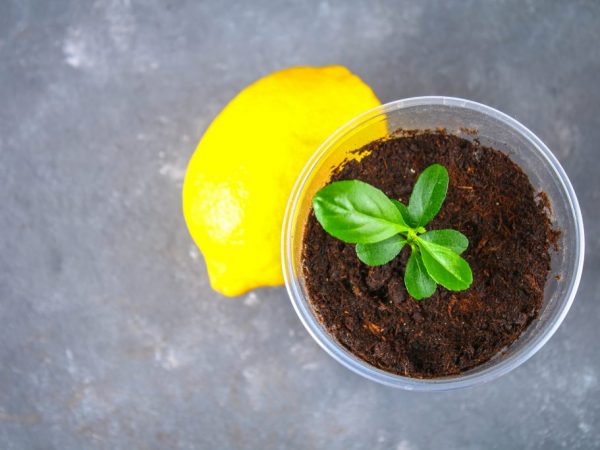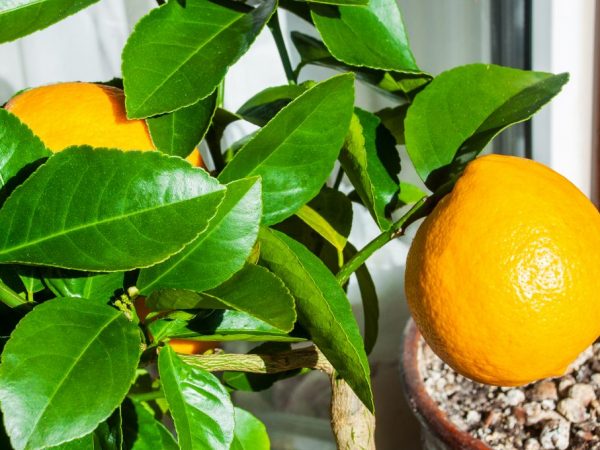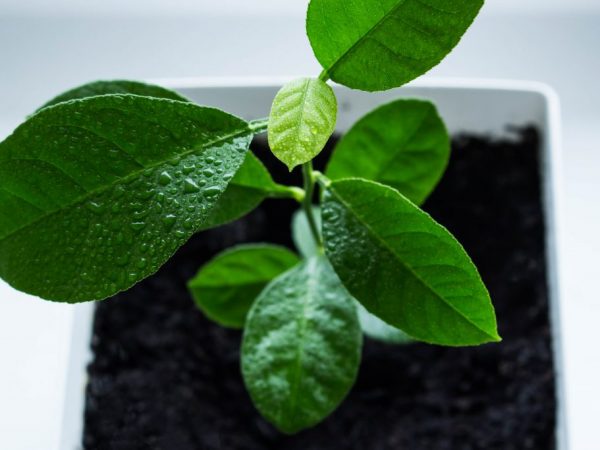Rules for planting and growing a lemon tree at home
Growing a lemon from a stone at home is a difficult and time-consuming process, but a beautiful tree with exotic fruits and a pleasant aroma will be a unique decoration for any interior.

Rules for planting and growing a lemon tree at home
Seed Growing Benefits
A healthy and strong tree is grown from lemon seed, which will bloom for 2-3 years of life.
Unlike cuttings, the seed method of growing makes it possible to get a plant:
- disease resistant;
- with a beautiful and lush crown;
- unpretentious in the care and conditions of detention.
Preparation of planting material
To germinate lemon seeds, buy a fruit. Almost every fruit contains seeds. When choosing a lemon, pay attention to its appearance: the fruit should be ripe, yellow. It should be free of rot and mechanical damage.
The seedling is germinated from the largest seeds. Their germination and survival rate is almost 100%. The seed is planted wet: it does not germinate when dried.
To force the seed to germinate, it is treated with any biostimulant: root, heteroauxin or epin. The solution is prepared according to the instructions. Lemon seeds are soaked for 24 hours before planting.
Pot
You need to plant lemon seeds in a special flower container made of plastic, or use any plastic container from yogurt, jelly or ice cream. You can also take half a plastic bottle. In such a container, the seed germinates well. Several drainage holes are drilled at the bottom to drain excess water.
The bottom of the container is covered with a drainage layer (1.5 cm) of eggshell, vermiculite, expanded clay, pebbles or small pieces of brick.
Substrate
It is possible to germinate a lemon from a seed in an ordinary commercial substrate intended for planting citrus fruits. At home, the mixture is prepared as follows: mix humus earth with leaf in equal parts, add 1-2 handfuls of peat earth and sand. The latter components will make the soil light and maintain its moisture and breathability. Before germination, the soil is moistened with a spray bottle.
Landing features
It is necessary to plant seeds in the ground to a depth of 2 cm. To successfully grow a lemon from a stone at home, 1-2 dozen seeds are planted at once. The strongest and most suitable for further cultivation are selected from the germinated seedlings. In addition, not all seedlings will be able to tolerate the grafting procedure.
After planting a lemon seed, the ground is irrigated with a spray bottle and covered with cut plastic bottles or transparent film. This makes it possible to further check whether the seeds have sprouted or not, without removing the shelter.
To grow a lemon from a seed at home, you will need to provide not only good greenhouse conditions, but also a stable temperature regime within 18-20 ° C with moderate air humidity of 40-50%. For this, the planting is placed on the windowsill, they are shaded at lunchtime.
Care of seedlings before germination consists in regular watering (irrigation from a spray bottle), airing and providing bright diffused lighting. A special role is given to watering. The sprouts should not be sprayed too often, otherwise they will rot. Moistening passes after the topsoil is completely dry.
Growing features

Take good care of your plant
Instructions for growing lemon from seed:
- After the seedlings break through the ground, they are in no hurry to open them. Under a plastic cover, the sprouts are kept until they have 2 pairs of leaves.
- Seedlings planted in a pot are gradually accustomed to room air, daily increasing the time spent in the room without shelter.
- Every day, plantings are sprayed from a spray bottle and placed in a well-lit place without direct sunlight.
Transfer
It is time to transplant sprouts accustomed to indoor air with 1-2 pairs of leaves into pots. The strongest plants with a thick stem are chosen for transplantation. The sprouts are transplanted into clay pots. In such a container, they feel comfortable and fully develop.
Subsequent transplantation into new pots is carried out as the tree and its root system grow. Before replanting the sprouts, the containers are soaked in water for 1-2 hours. A drainage layer (1 cm) of pebbles, expanded clay or broken shards is laid at the bottom of the pot. Then the soil is laid to the top from the same mixture as when planting seeds.
For a while, until the indoor lemon releases new leaves, it is covered with a transparent film or half of a plastic bottle. Before sheltering, the sprouts are irrigated from a spray bottle.
The rules for choosing quality sprouts:
- They look at the density of the crown. In high-quality seedlings, it contains at least 3-4 pairs of leaves. Choose a seedling with the smallest buds.
- A young plant should not have many thorns.
- Pay attention to the quality of the fastening of the leaves: they hold firmly and do not fall off at the slightest touch.
- Thin sprouts with bad leaves are discarded.
How to properly care
It will be possible to grow a lemon from a seed at home only if the tree is properly cared for.
Illumination
Illumination is a prerequisite that ensures the full development of the crown and good health for the lemon. In summer, the plant has enough normal daylight. In early spring and autumn, the lemon tree is artificially illuminated for 10-12 hours a day.
Temperature
In the process of growing, this tropical plant will require a stable temperature regime in the range of 25-27 ° C. Staying under the sun is excluded, otherwise the tender young tree will receive serious burns and die.
Humidity
Caring for seedlings of lemon pits involves ensuring the required level of humidity at home. This indicator for him should be in the range of 70-80%.
Indoor lemon responds well to daily irrigation of the crown, periodic shower with warm water - at least 2 times a month.
Transfer
This plant should be repotted frequently. This procedure promotes better development of the root system and stimulates the growth of the aerial part. Planting of adult plants in a new container of a larger size (5-6 cm in diameter larger than the previous one) is carried out at least once every 2 years, for young specimens, transplantation is carried out annually. The best time for this procedure is summer. If it becomes necessary to transplant indoor lemon in winter, this is done in February.
Top dressing

The plant needs fertilization
Between February and September nutrients are applied to lemons. This is the most active period for the growth of tropical plants. Biological and mineral fertilizers are used as top dressings, which are used alternately. Top dressing is applied in liquid form under the root. The main thing is not to overfeed the lemon, so they try to carry it out according to the instructions on the package.
Crown formation
The main care for lemons involves a crown formation procedure. To grow a tree with a lush crown, the apical shoot is cut, thus stimulating the development of lateral branches. The procedure is carried out in the first year of life of indoor lemons.
In order for the crown to be symmetrical, it is regularly rotated around its axis by a quarter. In the future, this technique has a positive effect on the quality and quantity of fruits.
Bloom
If a young lemon began to bloom quickly - already in the first year of life - all the buds are removed, because all the plant's strength will go to flowering, and it will simply wither away. Flowering near a tree is allowed when there are at least 7 pairs of leaves per flower bud.
Fruiting
With proper care of the plant, it is possible to grow a lemon from a store seed, which will bear fruit. True, the plant will give its first fruits at home no earlier than after 8-10 years.
To stimulate an earlier fruiting process, lemons are grafted. Vaccinations are made to other citrus fruits: tangerine or grapefruit. For vaccinations to give a positive result, they are carried out in the spring or summer.
There is another way for a lemon to bear fruit - pinching. In addition, after such manipulation, the lateral shoots (of the second order) are pinched to a length of 18 cm. The procedure is repeated until the branches of the 4th order appear. The first flower buds are formed on them, and then the fruits.
Helpful hints
Recommendations on how to care for lemon:
- Use only warm, settled water for irrigation. Rainwater and melt water at room temperature are also suitable.
- In the first months of life, do not feed the plant, otherwise it will burn out and dry out.
- Avoid drafts and sudden changes in temperature, otherwise the tree will wither, turn yellow and shed the foliage.
- Reduce watering frequency towards fall. Moisten as the top layer of the earth dries out.
- Remove all deformed and damaged ones to prevent the process of decay and disease infestation. Yellowed and dried leaves are also subject to removal.
Conclusion
To grow a lemon tree at home from seed, it is important to use the right technology. If you follow it, the growing process will be successful and productive. He will obey any novice gardener.


